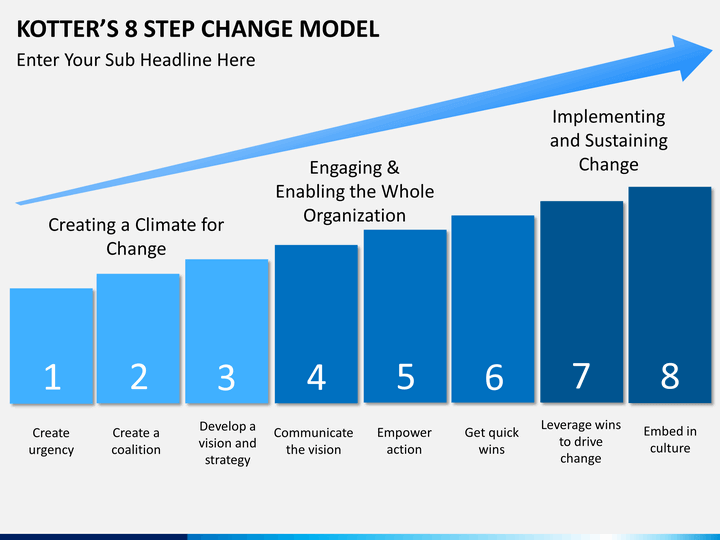Ah yes, the sweet smell of change is in the air.
The digital transformation of supply chain management, more specifically procurement and sourcing functions, is becoming a part of the new normal in business. Organizations are beginning to hop aboard the technology train en route to their end destination: Innovation City and Top-Line Value Ave. . Along the way, there will be barriers to a smooth journey, but taking incremental steps towards change will allow organizations to overcome challenges.
I’m no cowboy, but “There is a saying used by shooters that applies: “Slow is smooth, smooth is fast.” In this context, it means that change management is vital to digital transformation, no matter how imminent the external threat” (O’Marah 2017).
Without management of change, no change occurs.
But, as our lungs fill wit hope and the air around us smells of fresh baked change and innovation, there remains an unflattering stench lying beneath the floorboards of our organizations….
Reluctance.
It meets us at every twist and turn along the railways of change. Senior stakeholders doubt the impact of digital transformation, traditionalists scream ‘but, we’ve always done it this way and it works’, organizations lack quality supply chain data sets, and all the while the gap grows bigger between those who dare to change and those who dare to sit idly.
Hopefully this article will provide you with some insights of how change is best managed, and we’ll all be a part of a more technologically advanced and smarter future.
An Infrastructure for Change
Implementing change and managing change are no easy task, and for that very reason change requires infrastructure, processes and clearly defined actions.
Recently, I read Magnus Carlsson’s book, Strategic Sourcing and Category Management: Lessons learned at IKEA. The book is a masterful composition and guideline of how a procurement and sourcing organization can start building a quality infrastructure by gaining inspiration from IKEA’s triumphs and failures.
After creating — in essence — the bible for strategic sourcing and category management, Carlsson dedicates the entirety of last two chapters to speak about change management, and change as a function for reaching goals and building organizational value.
Carlsson utilizes John Kotter’s 8-step change model as an example for building an infrastructure for change. Utilizing this concrete, yet flexible, model for a change process allows the ability to plug-and-play, making it customizable to the specifics of an organization’s desired change project.
Utilizing Kotter’s model allows us — the dreamers of change — to ground ourselves in a solidified vision of change, identify opportunities, avoid pitfalls, maximize wins, and ultimately create organizational change leading to shifts in an organization’s culture.
Change management will be an increasing focus in the digitalization of the global supply chain. Let’s flush out Kotter’s model for change and see if we can apply it to the digital transformation we’d like to see in the global supply chain.
Kotter’s 8 Step Model for Change & Change Management
Pictured below is Kotter’s 8-step model for change.

I figured the best way to best understand Kotter’s change process, and how it could help with managing digital transformation of your supply chain, is to take things step-by-step.
Let’s start by introducing each of the 8 steps, defining them in our own words, and apply a case of desired change to build context. I will present a business case of desired change that Kodiak Hub crosses path with in many organizations so I can speak from a position of expertise. The case will be based upon:
Digitalization of Strategic Sourcing and Supplier Relationship Management.
As Woodrow Wilson once said, “If you want to make enemies, try to change something.”
Change is tough, but let’s see if we can’t just be just a little bit tougher!
1) Establishing a Sense of Urgency
Kotter’s first step focuses on overcoming the resistance to change that an organization may have. On a more meta/existential level, it’s about overcoming the resistance to change we inherently possess as humans.
In business, Kotter identifies that 75% of an organization’s management needs to be convinced by change in order for it to become a blip on the organization’s radar.
Case: The procurement/sourcing organization needs to present the value propositions/technical proposition that digitalization can add to an organization’s top-line. An overwhelming majority of management needs to be on board, but this will only occur if enough noise is made, and the initial advocators display value potentiality.
2) Creating the Guiding Coalition
This step requires the delegation of ‘go-to’ advocates for the desired change. Having leadership in place will put a face behind the movement, and these individuals should be highly competent, well respected and hold relevant power in the organization. This step is really about creating role models for change.
Case: Locate the relevant line managers (category managers, strategic sourcing managers, supplier development managers) that have influence and expertise within their role, and empower them. If you want to digitally transform an entire function of your organization then you’re going to have to throw resources at the coalition. Do not underestimate the importance of rallying behind managers that have impact within the line (Carlsson 2015 p. 159).
3 & 4) Develop a Vision & Strategy + Communicate the Vision
Unify your team behind a vision, and reiterate the vision by leveraging your coalition’s influence. Your managers of change will be instrumental in communicating desired change to other members in the organization. The goal of developing a vision and communicating the vision isn’t to just have people get behind something, but to live the vision.
Kotter’s states that the characteristics of a quality vision are:
- Imaginable
- Desirable
- Feasible
- Flexible
- Communicable
A lot of the unification/communication of a vision will go into a focus on messaging. Condensing and simplifying a message will need to be a key focus from your change advocates.
Carlsson offers a fantastic anecdote from his time at Ikea to highlight how the communication of a quality vision can become a part of who we are, not just as business professionals, but humans.
“The managers’ company cars were for many years equipped with steel wheels, even though by then all new cars were supplied only with alloy wheels. When I asked the person responsible about this strange phenomenon it turned out that, for a small fee, he had replaced the alloy wheels with steel ones — because they looked much cheaper. This was maybe a private interpretation of Ikea values. Or maybe not” (Carlsson 2015 p. 167)
Case: Cut out the buzzwords that can often be thrown around when organizations begin to discuss the implementation of new digital solutions. Simplify the messaging to quickly underline the value of digitalization in strategic sourcing and SRM: time saved, money saved and goals met.
Speak the language that everyone understands — ROI. Money talks, and if you can build a business case for how digitalization in said functions will create a return on investment, your organization will have an easy time to align themselves behind the vision.
5) Empowering Employees for Broad-based Action
Empowering action is a step that is required after communicating the vision of change. It’s necessary because if your organization is able to reach steps 3&4, you will soon experience doubt, identification of lacked competency, managers who serve as obstructions and conflict.
Treat naysayers with respect and listen to their concerns. There may be value in their concerns.
Case: This is a stage where there needs to be a reassurance and reiteration of the value proposition that change will offer to your organization. Find your champions. Make sure that the change management team is still able to realize the task at hand — because the real work begins in steps 6–8.
Learn more about how people is the key to digital transformation within procurement.
6) Generating Short-term Wins
“Kotter states that quick wins must be directly related to the change and that they are essential both to motivate the efforts and to keep the opposition at bay” (Carlsson 2015 p. 168).
Ensure that your organization has an infrastructure for gauging the progression of the desired change. This is a crucial element of the overall change management being successful. Change isn’t just about action; it’s about motivating action.
Case: Cleaning up data sets, uploading data, and gaining familiarity with a solution could be seen as a first short-term win when digitalizing your sourcing and SRM functions. Along the way, ensure that you can show daily, weekly and monthly progression. This will instill confidence in the not so confident, and buy you the time you need to create promised impact on top-line value.
7) Consolidating Gains & Producing More Change
This is the step of the change process where your organization/change advocates need to be ready to push the pedal to the metal, and not become lackadaisical in the vision of change. Winning in the short-term is crucial, but the allocation/reallocation of resources needs to be defined/redefined after wins, and the urgency for change will need a revamping as well.
Case: At this point, you’re up and running in a digital solution, you’re feeling comfortable, and things are going your way. Value is starting to be created, and your organization can feel the impact of your digital procurement strategy. Now is the time to rollout the strategy/engage more project managers.
You’re not as dependent of your manager’s approval for change because value has already been proven. Now, you need to get creative in the way you’ll go forward. You can always consult your service providers/champions in your organization. Whatever you do, don’t reduce the urgency you began the project with.
8) Anchoring New Approaches in the Culture
You will see consequential culture shifts in your organization after properly managing a change process. This could be something that has shifted within a single team, an entire business unit, an entire company, or an entire group. One way or the other, change will be apparent if you’ve managed the process correctly.
Do note…. Change that hasn’t impacted the culture of an organization will most likely be just that — shot-term change.
Case: At this point your role, processes, and functions will have seen a shift in daily, monthly and yearly activities and performance. Make sure that your C-suite knows where that change originated. This is the last step: Confirming that your digitalizion project has created value and the change is here to stay.
Rethinking the Framework for Transformation
Pictured below is a “Framework for Digital Transformation of Supply Chain Management” developed by CapGemini in 2017. This is a holistic approach for creating digital transformation in an organization’s supply chain.

However, after delving into the importance of change management, the second picture below is a rethought framework for digital transformation of supply chain management.
The added element is, of course, change management. Without a continuous focus on implementing and managing of change, your organization will have one heck of a time trying to reach/develop shared business goals within digital transformation.

Key Takeaways
What does this all mean, and how will we start to make sense of it?
Well… I think it starts by seeing the change that you want to implement in your organization. Be it a new P2P system, automated inventory management or more intelligent analytics about your supplier’s performance.
If you like the framework provided by Kotter’s model, then see if it works for implementing your change. Whatever you do, whatever you change, we’ll be here rooting you on. If you forget about all the text about and there’s key learnings you can take away from this post:
Remember…
- You can’t change ’em all
- Change is relative to the ability to change
- Change takes time
Until next week.












